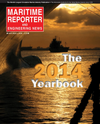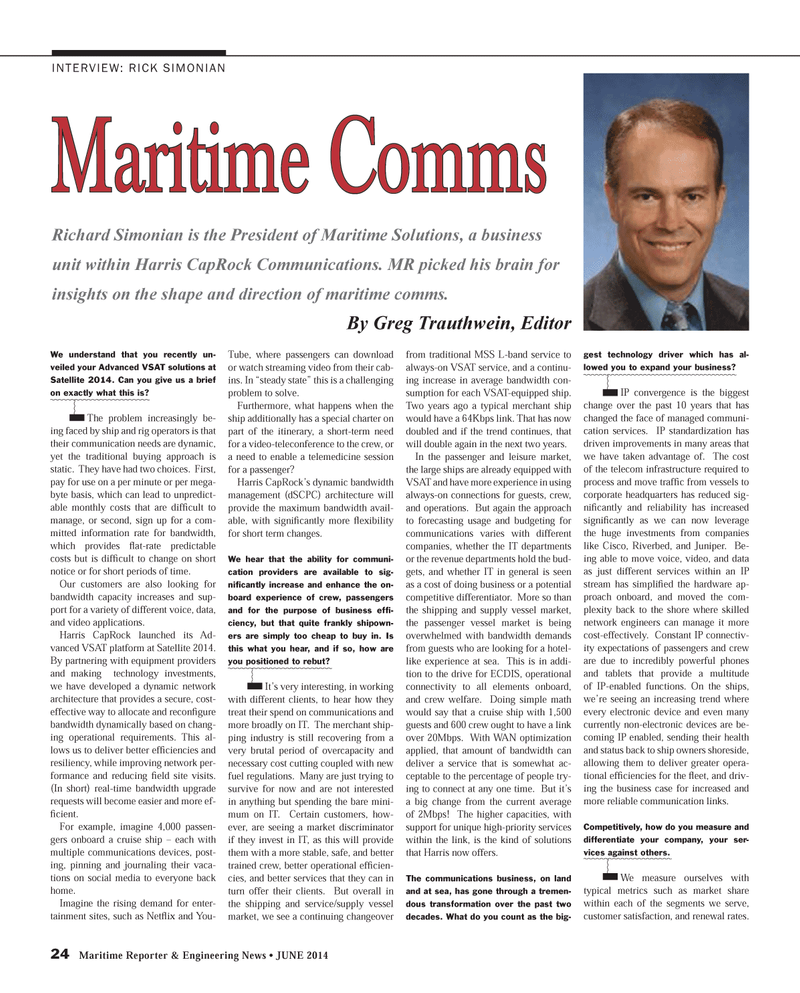
Page 24: of Maritime Reporter Magazine (June 2014)
Annual World Yearbook
Read this page in Pdf, Flash or Html5 edition of June 2014 Maritime Reporter Magazine
24 Maritime Reporter & Engineering News • JUNE 2014
We understand that you recently un- veiled your Advanced VSAT solutions at
Satellite 2014. Can you give us a brief on exactly what this is? The problem increasingly be- ing faced by ship and rig operators is that their communication needs are dynamic, yet the traditional buying approach is static. They have had two choices. First, pay for use on a per minute or per mega- byte basis, which can lead to unpredict- able monthly costs that are dif? cult to manage, or second, sign up for a com- mitted information rate for bandwidth, which provides ? at-rate predictable costs but is dif? cult to change on short notice or for short periods of time.
Our customers are also looking for bandwidth capacity increases and sup- port for a variety of different voice, data, and video applications.
Harris CapRock launched its Ad- vanced VSAT platform at Satellite 2014.
By partnering with equipment providers and making technology investments, we have developed a dynamic network architecture that provides a secure, cost- effective way to allocate and recon? gure bandwidth dynamically based on chang- ing operational requirements. This al- lows us to deliver better ef? ciencies and resiliency, while improving network per- formance and reducing ? eld site visits. (In short) real-time bandwidth upgrade requests will become easier and more ef- ? cient.
For example, imagine 4,000 passen- gers onboard a cruise ship – each with multiple communications devices, post- ing, pinning and journaling their vaca- tions on social media to everyone back home.
Imagine the rising demand for enter- tainment sites, such as Net? ix and You-
Tube, where passengers can download or watch streaming video from their cab- ins. In “steady state” this is a challenging problem to solve.
Furthermore, what happens when the ship additionally has a special charter on part of the itinerary, a short-term need for a video-teleconference to the crew, or a need to enable a telemedicine session for a passenger?
Harris CapRock’s dynamic bandwidth management (dSCPC) architecture will provide the maximum bandwidth avail- able, with signi? cantly more ? exibility for short term changes.
We hear that the ability for communi- cation providers are available to sig- nifi cantly increase and enhance the on- board experience of crew, passengers and for the purpose of business effi - ciency, but that quite frankly shipown- ers are simply too cheap to buy in. Is this what you hear, and if so, how are you positioned to rebut? It’s very interesting, in working with different clients, to hear how they treat their spend on communications and more broadly on IT. The merchant ship- ping industry is still recovering from a very brutal period of overcapacity and necessary cost cutting coupled with new fuel regulations. Many are just trying to survive for now and are not interested in anything but spending the bare mini- mum on IT. Certain customers, how- ever, are seeing a market discriminator if they invest in IT, as this will provide them with a more stable, safe, and better trained crew, better operational ef? cien- cies, and better services that they can in turn offer their clients. But overall in the shipping and service/supply vessel market, we see a continuing changeover from traditional MSS L-band service to always-on VSAT service, and a continu- ing increase in average bandwidth con- sumption for each VSAT-equipped ship.
Two years ago a typical merchant ship would have a 64Kbps link. That has now doubled and if the trend continues, that will double again in the next two years.
In the passenger and leisure market, the large ships are already equipped with
VSAT and have more experience in using always-on connections for guests, crew, and operations. But again the approach to forecasting usage and budgeting for communications varies with different companies, whether the IT departments or the revenue departments hold the bud- gets, and whether IT in general is seen as a cost of doing business or a potential competitive differentiator. More so than the shipping and supply vessel market, the passenger vessel market is being overwhelmed with bandwidth demands from guests who are looking for a hotel- like experience at sea. This is in addi- tion to the drive for ECDIS, operational connectivity to all elements onboard, and crew welfare. Doing simple math would say that a cruise ship with 1,500 guests and 600 crew ought to have a link over 20Mbps. With WAN optimization applied, that amount of bandwidth can deliver a service that is somewhat ac- ceptable to the percentage of people try- ing to connect at any one time. But it’s a big change from the current average of 2Mbps! The higher capacities, with support for unique high-priority services within the link, is the kind of solutions that Harris now offers.
The communications business, on land and at sea, has gone through a tremen- dous transformation over the past two decades. What do you count as the big- gest technology driver which has al- lowed you to expand your business? IP convergence is the biggest change over the past 10 years that has changed the face of managed communi- cation services. IP standardization has driven improvements in many areas that we have taken advantage of. The cost of the telecom infrastructure required to process and move traf? c from vessels to corporate headquarters has reduced sig- ni? cantly and reliability has increased signi? cantly as we can now leverage the huge investments from companies like Cisco, Riverbed, and Juniper. Be- ing able to move voice, video, and data as just different services within an IP stream has simpli? ed the hardware ap- proach onboard, and moved the com- plexity back to the shore where skilled network engineers can manage it more cost-effectively. Constant IP connectiv- ity expectations of passengers and crew are due to incredibly powerful phones and tablets that provide a multitude of IP-enabled functions. On the ships, we’re seeing an increasing trend where every electronic device and even many currently non-electronic devices are be- coming IP enabled, sending their health and status back to ship owners shoreside, allowing them to deliver greater opera- tional ef? ciencies for the ? eet, and driv- ing the business case for increased and more reliable communication links.
Competitively, how do you measure and differentiate your company, your ser- vices against others. We measure ourselves with typical metrics such as market share within each of the segments we serve, customer satisfaction, and renewal rates.
Maritime Comms
Richard Simonian is the President of Maritime Solutions, a business unit within Harris CapRock Communications. MR picked his brain for insights on the shape and direction of maritime comms.
By Greg Trauthwein, Editor
INTERVIEW: RICK SIMONIAN
MR #6 (18-25).indd 24 5/28/2014 12:14:19 PM

 23
23

 25
25
